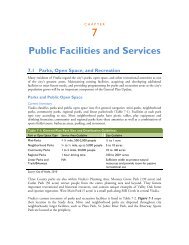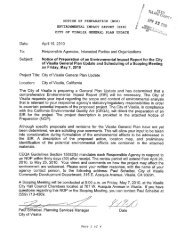General Plan Update Review Committee Draft Elements Part 2 For ...
General Plan Update Review Committee Draft Elements Part 2 For ...
General Plan Update Review Committee Draft Elements Part 2 For ...
Create successful ePaper yourself
Turn your PDF publications into a flip-book with our unique Google optimized e-Paper software.
other businesses, including a used car lot and a fast<br />
food restaurant.<br />
Agricultural Operations<br />
AERIAL APPLICATION AIRCRAFT (CROP DUSTERS) AND<br />
OTHER FARMING OPERATIONS<br />
Aerial application aircraft are frequently used to spray<br />
crops or to spread seed or fertilizers. The horsepower<br />
ratings of various aircraft used for aerial application<br />
generally ranges from 300 to 1200. Measurements<br />
conducted with a Piper Brave (300 hp/3-bladed propeller)<br />
show noise ranged from 85-88 dBA at about<br />
600 feet, and 97-100 dBA at fifty feet. By contrast,<br />
measurements conducted with a Grumman Ag Cat<br />
(600 hp/2-bladed propeller indicated a maximum<br />
noise level of 103 dBA at 100 to 150 feet overhead.<br />
Finally, measurements taken at the Tulare Municipal<br />
Airport in 1998 showed noise from in the 90-95 dBA<br />
range at approximately 100 feet overhead.<br />
Other Noise Sources<br />
TULARE COUNTY LANDFILL, ROAD 80<br />
Operations at the Tulare County Landfill have not<br />
changed since the 1995 <strong>General</strong> <strong>Plan</strong>. Noise monitoring<br />
for this solid waste landfill documented noise<br />
from refuse trucks and automobiles entering and<br />
leaving the landfill, and the heavy equipment use<br />
to manage and cover the refuse. Noise levels ranged<br />
from 63-68 dBA at a distance of 300 feet. The posted<br />
operating hours of the landfill are 8:00 a.m. to 4:00<br />
p.m., seven days a week.<br />
GENERAL SERVICE COMMERCIAL AND LIGHT<br />
INDUSTRIAL USES<br />
Noise sources associated with service commercial<br />
uses such as automotive repair facilities, wrecking<br />
yards, tire installation centers, car washes, loading<br />
docks, etc., are found at various locations within the<br />
city. The noise emissions of these types of uses are<br />
dependent on many factors and are therefore difficult<br />
to quantify precisely. Nonetheless, noise generated by<br />
the these uses contributes to the ambient noise environment<br />
in the immediate vicinity of these uses and<br />
should be considered where either new noise-sensitive<br />
uses are proposed nearby or where similar uses are<br />
proposed in existing residential areas.<br />
PARKS AND SCHOOL PLAYING FIELDS<br />
There are numerous park and school uses within the<br />
city. Noise generated by these uses depends on the<br />
age and number of people utilizing the respective<br />
facility at a given time and the types of activities they<br />
are engaged in. School playing field activities tend<br />
to generate more noise than those of neighborhood<br />
parks, as the intensity of school playground usage<br />
tends to be higher. At a distance of 100 feet from an<br />
elementary school playground being used by 100 students,<br />
average and maximum noise levels of 60 and<br />
75 dB, respectively, can be expected. At organized<br />
events such as high-school football games with large<br />
crowds and public address systems, the noise generation<br />
is often significantly higher. As with service<br />
commercial uses, the noise generation of parks and<br />
school playing fields is variable.<br />
DRAFT ELEMENTS<br />
<strong>For</strong> <strong>General</strong> <strong>Plan</strong> <strong>Update</strong> <strong>Review</strong> <strong>Committee</strong><br />
AUGUST 2012 8-25




